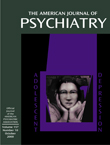Dr. Wu and Colleagues Reply
To the Editor: We appreciate the suggestion that 1) “a deficient adenosinergic inhibitory tone” at baseline accounts for the higher local metabolic rates in responders than in nonresponders and comparison subjects and 2) “increases in extracellular adenosine” account for the reduced metabolic rates observed in responders after sleep deprivation. Whether this interesting adenosine hypothesis will weather the tests of time remains to be seen.
If adenosine inhibits the local cerebral glucose metabolic rate, then the present patterns of relative local cerebral glucose metabolic rates could possibly fit a model of 1) loss of adenosinergic tone at baseline in depressed responders or 2) augmentation of adenosinergic function with sleep deprivation in responders. However, insofar as the administration of caffeine mimics “deficient adenosinergic inhibitory tone,” its effects on functional brain imaging are complex and not necessarily consistent with the baseline patterns of local cerebral glucose metabolic rates in responders and nonresponders to sleep deprivation. Caffeine increases the local cerebral glucose metabolic rate throughout the brain but decreases cerebral blood flow at the same time, inducing a relative brain hypoperfusion (1–3). Administration of caffeine to normal volunteers does reduce slow-wave activity during non-REM sleep and prolongs sleep latency (4), both of which are characteristic of the sleep of depressed patients, suggesting that some depressed patients might have deficient adenosinergic tone.
In addition, adenosine is only one of many proposed “endogenous sleep-promoting substances,” including prostaglandin D2, interleukin-1, or muramyl peptides, which may accumulate during sleep deprivation and promote sleep (5–7). Any of these other substances could also theoretically act in the fashion proposed for adenosine.
We welcome speculation about the mechanisms of the antidepressant effects of sleep deprivation, particularly neurochemical changes or gene expression, which may lead to new antidepressant medications. Sleep deprivation is one of the easiest and most well-documented experimental antidepressant treatments known.
1. Nelig A, Lucignani G, Kadekaro M, Porrino JL, Sokoloff L: Effects of acute administration of caffeine on local cerebral glucose utilization in the rat. Eur J Pharmacol 1984; 101:9–100Google Scholar
2. Cameron OG, Modell JG, Hariharan M: Caffeine and human cerebral blood flow: a positron emission tomography study. Life Sci 1990; 47:1141–1146Google Scholar
3. Nelig A, Daval JL, Debry G: Caffeine and the central nervous system: mechanisms of action, biochemical, metabolic and psychostimulant effects. Brain Res Brain Res Rev 1992; 17:139–170Crossref, Medline, Google Scholar
4. Landolt HP, Werth E, Borbely AA, Dijk DJ: Caffeine intake (200 mg) in the morning affects human sleep and EEG power spectra at night. Brain Res 1995; 675:67–74Crossref, Medline, Google Scholar
5. Huston JP, Haas HL, Boix F, Pfister M, Decking U, Schrader J, Schwarting RK: Extracellular adenosine levels in neostriatum and hippocampus during rest and activity periods of rats. Neuroscience 1996; 73:99–107Crossref, Medline, Google Scholar
6. Porkka-Heiskanen T: Adenosine in sleep and wakefulness. Ann Med 1999; 31:125–129Crossref, Medline, Google Scholar
7. Krueger JM, Majde JA: Cytokines and sleep. Int Arch Allergy Immunol 1995; 106:97–100Crossref, Medline, Google Scholar



